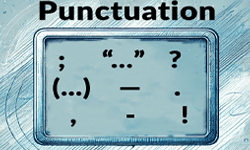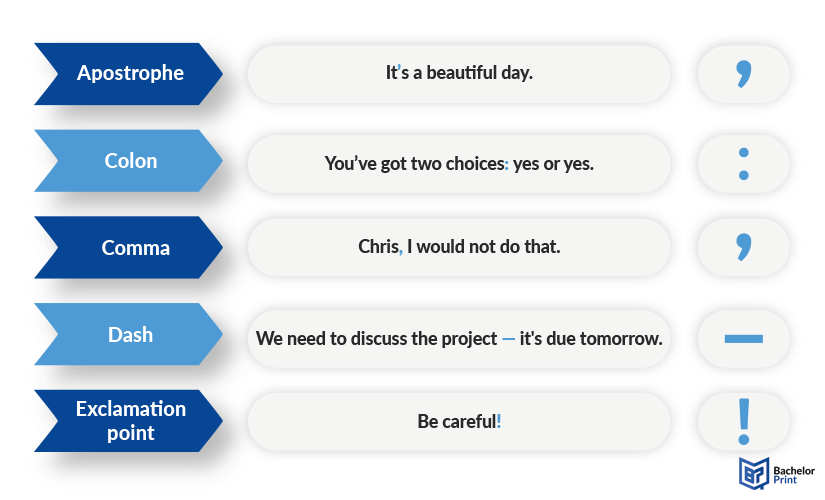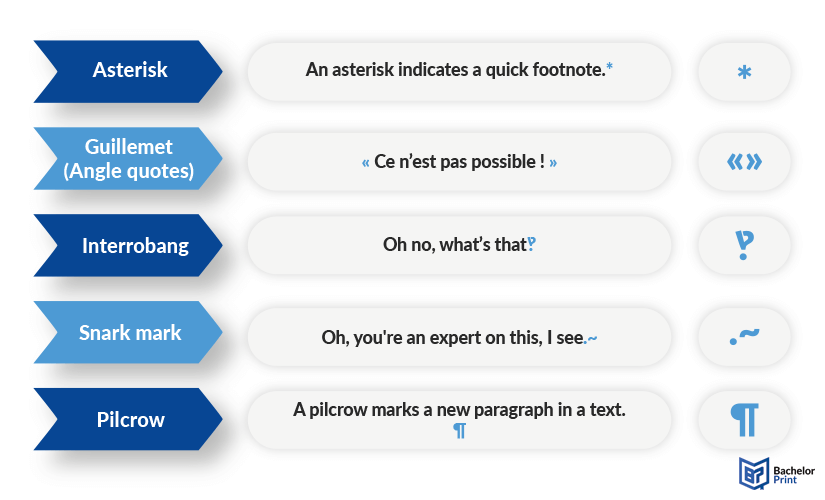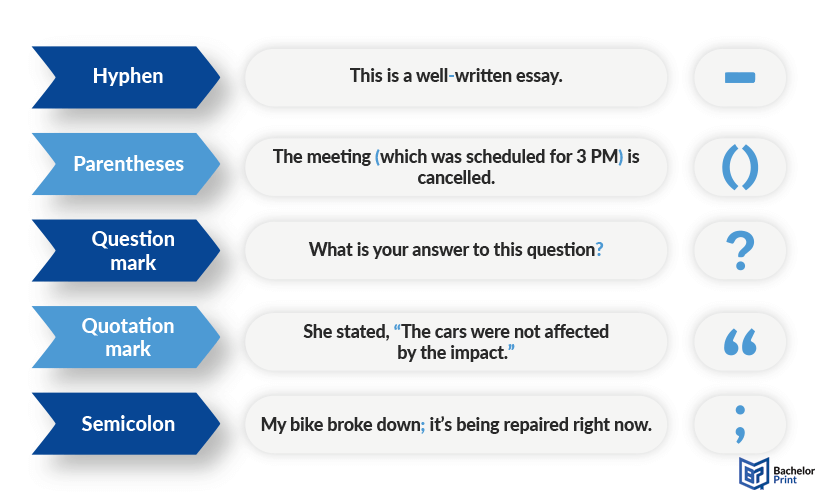
In academic writing, grammatical mistakes and language rules are frequently occurring obstacles in the process of writing a research paper or dissertation. In particular, punctuation may create wrong or ambiguous meanings when used incorrectly. This article outlines commonly made mistakes and navigates you to more detailed articles, dealing with each punctuation mark individually.
Definition: Punctuation
Punctuation defines symbols used in writing to provide a clear distinction between sentences, phrases, and paragraphs. These symbols convey specific meanings and clarify the structure of words or phrases and show where to pause or how to emphasize certain words. Common punctuation marks in formal writing include apostrophes, colons, commas, dashes, exclamation marks, hyphens, parentheses, question marks, quotation marks, and semicolons.
Common punctuation errors
Punctuation may seem like a small part of English writing, but it holds immense power. Even the most seasoned writers can stumble over punctuation rules, leading to basic errors that confuse English readers or distort the intended message. Here are some of the most common mistakes to watch out for.
Incorrect apostrophe punctuation
Apostrophes are often mistakenly used to pluralize words. Instead, they are used to indicate possession, except when it comes to pronouns where possessive pronouns without apostrophes are used. Furthermore, apostrophes are used in contractions to replace omitted letters, which can be seen in the examples below.
Incorrect quotation marks punctuation
Quotation marks are often misused in academic writing. The following rules outline when it is appropriate to use quotation marks:
- To cite the exact words of someone else.
- To indicate the titles of articles, short stories, poems, plays, movies, or other media.
- To highlight slang terms or foreign words.
- To express irony or sarcasm in a phrase.
Incorrect semicolon punctuation
Other common mistakes are made when punctuating semicolons, as it is often misconceived that comma rules apply. However, semicolons are used much less than commas and have their own rules. The most common ways to use semicolons are when connecting…
- A list within a series
- Two complete and related sentences
- Two related sentences, where the second sentence starts with a conjunctive adverb
Incorrect period & comma punctuation
In American English, periods are placed inside the quotation marks. However, in British and Canadian English, the periods are placed outside the quotation marks.
Commas are frequently overused, and the rules for commas are often unclear. The following list outlines when it is correct to use commas:
- In lists or series
- In dates, addresses, titles, and numbers
- Between clauses that are connected with conjunctions
- After introductory clauses
- With sentences that can’t stand alone or don’t have direct reference to the main clause
- Sentence parts with subject-verb agreement
- With nonessential references to a noun
- After directly addressing someone by name
numerous advantages for Canadian students:
- ✓ 3D live preview of your configuration
- ✓ Free express delivery for every order
- ✓ High-quality bindings with individual embossing

Articles about punctuation marks
Find articles about different types of punctuation listed in the table below:
| Punctuation | Example |
| Apostrophes (‘) | It’s a beautiful day. |
| Colons (:) | You’ve got two choices: yes or yes. |
| Commas (,) | Chris, I would not do that. |
| Dashes (– & —) | We need to discuss the project — it's due tomorrow. |
| Exclamation points (!) | Be careful! |
| Hyphens (-) | This is a well-written essay. |
| Parentheses () | The meeting (which was scheduled for 3 PM) is cancelled. |
| Question marks (?) | What is your answer to this question? |
| Quotation marks (“…”) | As she previously stated, “The cars were not affected by the impact.” |
| Semicolons (;) | My bike broke down; it’s being repaired right now. |
Rare punctuation marks
Punctuation goes beyond the familiar periods and commas. Rare punctuation marks, while not commonly used, have historical significance and practical uses. Here’s a closer look at some of these fascinating symbols.
The interrobang is a combination of a question mark and an exclamation point and does exactly what one would expect: combine astonishment and inquiry. It was first introduced in the 1960s but remains underused despite its versatility.
The asterisk is used for footnotes, emphasis, or tagging omitted text. A single asterisk (*) implies footnotes or the missing letters in swear words. The three-asterisk symbol in the form of a triangle is called an asterism, originating from the astronomical term for a group of stars, and is used to indicate breaks in text or chapters. This, however, has never caught on, as publishers tend to skip a line using three asterisks in a row (***) to separate texts.
In the early 2000s, numerous new marks were created to denote irony or sarcasm. The snark mark is used to indicate sarcasm in a sentence where it might be misunderstood. It is a period followed by a tilde, suggesting a sideways exclamation point. Inspired by Alcanter de Brahm’s irony mark (⸮), it was created by the typographer Choz Cunningham to encourage readers to add a snarky undertone to a sentence beyond its literal interpretation. This is one form of the snark mark symbol created in 1580 by Henry Denham.
The hedera, also known as the Latin word for “ivy,” is a decorative mark that resembles an ivy leaf that can either be used horizontally (❦) or vertically (❧). Historically, it was used in medieval manuscripts when changing the subject or indicating a new speaker or stanza.
The pilcrow is a practical symbol that represents a paragraph break or news section in text. In modern times, the pilcrow is often seen in word-processing programs like Microsoft Word, in proofreading to symbolize where a new paragraph should start, or in legal writing when citing a specific paragraph.
Guillemets, also referred to as angle quotes, double chevrons, or French quotation marks, are a type of punctuation used in various languages to indicate speech or quoted text. Unlike common belief, the “guillemet” is a misnomer, as it is not named after the French printer Guillaume Le Bé. They’re mostly found in French, Italian, Spanish, and Russian printing, depending on the region.
The three images below depict 15 common and uncommon punctuation marks that we have learned about in this article.
FAQs
The 14 punctuation marks in English are:
- period (.)
- question mark (?)
- exclamation point (!)
- comma (,)
- semicolon (;)
- colon (:)
- apostrophe (‘)
- quotation marks (” “)
- hyphen (-)
- dash (– or —)
- parentheses ()
- brackets ([])
- braces ({})
- ellipsis (…)
Punctuation represents symbols or a series of marks that make up a clear distinction between sentences, phrases, and paragraphs. They also indicate and alter meanings of words or sentences.
Semicolons can be used to connect two related independent clauses or to separate items in a complex list.
Examples
- I have a meeting tomorrow; I need to prepare tonight.
- We visited Paris, France; Tokyo, Japan; and Berlin, Germany.
The en dash can be used to indicate ranges, e.g., “The event runs from 5–7 PM.”
The em dash can be used to add emphasis, interruption, or additional information, e.g., “She arrived late—but with a valid excuse.”



